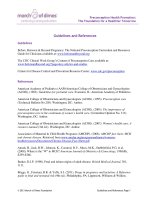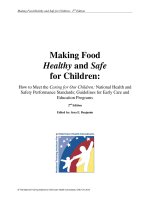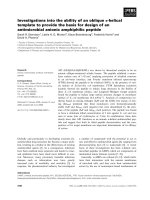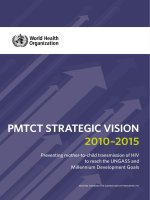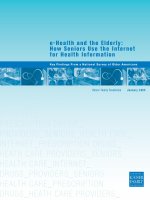HOW TO BEAT THE HEAT FOR A SAFE SUMMER doc
Bạn đang xem bản rút gọn của tài liệu. Xem và tải ngay bản đầy đủ của tài liệu tại đây (381.95 KB, 12 trang )
Centro Nazionale per la Prevenzione
e il Controllo delle Malattie
HOW TO BEAT THE HEAT
FOR A SAFE SUMMER
Handbook on home care
for the elderly
3
HOW TO BEAT THE HEATFOR A SAFE SUMMER
It is vital to be aware
of precautions needed
to protect the health
of persons at risk
Summer is a relaxing time of the year when fine weather is usual-
ly anticipated. Summer temperatures are higher when compared
to other seasons of the year, allowing our organism to benefit from
a period of less stressful conditions.
In certain conditions, the climate may become abnormally hot,
and this event, especially when associated with very high humidi-
ty levels, can cause a danger to health if these high temperatures
persist also at night and continue for a period of more than 48
hours. It is in these circumstances that we are faced with what is
defined as a “heatwave”.
During the summer of 2003, conditions of excessive heat occur-
red in Italy and in other European countries, causing an increase
in hospital admissions and deaths, particularly among the elderly
and with a focus on the big cities, Experts have forecast that he-
atwaves will become even more frequent in Europe in the near
future, and we therefore need to be aware of the safety measures
needed to combat these events effectively and which, above all,
put the elderly population at risk.
This pamphlet is aimed at those providing home care to the
elderly.
Heatwave
FOR A SAFE SUMMER
4
HOW TO BEAT THE HEAT
Those most exposed
to danger
Am I assisting a person who has a high risk of damage from
excessive heat?
To reply to this question, a number of individually-related charac-
teristics need to be known.
75 years of age and above Yes No
Heart disease? Yes No
Alzheimer’s disease? Yes No
Respiratory problems? Yes No
Mobility problems? Yes No
Bed sores? Yes No
Able to eat unaided? Yes No
Parkinson’s disease? Yes No
Psychiatric disorders? Yes No
Diabetes and/or renal insufficiency? Yes No
Habitually takes more than 4 different types of
prescribed medicines
Yes No
High temperature? Yes No
Does the assisted person fit the following
description?
?
5
HOW TO BEAT THE HEATFOR A SAFE SUMMER
Learn to recognise
the symptoms that reveal
a serious level of suffering
due to extreme heat
If at least one reply relating to the assisted person is affir-
mative (Yes), you need to be extra vigilant when heat becomes
intolerable even at night, and take action to reduce the risk of
damage to health.
Why is a heatwave dangerous to the health of vulnerable
persons?
■
During a period of hot weather, a healthy organism is able to
combat the climatic effects through perspiration, resulting in a lo-
wering of the skin temperature. This perspiration consists almost
entirely of water, in which minerals are dissolved. In extreme heat
conditions, we can lose a number of litres of water a day through
perspiration, and these need to be replenished by drinking lots of
water.
■
In people at risk, the regulation of skin temperature through
the production of perspiration may function poorly, or their liquid
intake may be insufficient. Many people at risk (those covered by
the first question) may not feel thirsty or want to drink even when
they perspire a lot, or they may not be able to drink. In these cir-
cumstances the body temperature may rise, or the body may lose
too much water to be able to survive.
Do any warning signs or symptoms exist?
Some signs and symptoms exist and are revealed under condi-
tions that allow for their remedy: the appearance or intensification
of muscle cramps, rashes (reddening of the skin) and papules
(small hard swellings on the skin).
In such a deteriorating situation, the assisted person may expe-
rience mental confusion or an aggravation of mental confusion,
headaches, convulsions, a rise in skin temperature. Very often
these symptoms are not clearly recognised in those suffering from
dementia. A person thus affected can, for example, be suffering
from a headache but may not be able to communicate this, and
instead present a state of agitation, or, on the contrary, sleepi-
ness.
However, wherever possible, timely action should be taken in the
initial stages when the first symptoms, not yet serious, occur, and
before signals of severe distress appear in the assisted person.
FOR A SAFE SUMMER
6
HOW TO BEAT THE HEAT
Take action on factors
that may cause distress
and malaise
In fact, when these symptoms do occur, any action taken usually
results ineffective and the emergency health services will need to
be called upon (see last reply).
What preventive measures should be taken during the sum-
mer months?
■
During the summer months it is prudent to carry out general
measures aimed at confronting possible heatwaves in the best
way available. Such measures reflect individual living environ-
ments, life-styles, and the care required for the assisted person
concerned (see following replies).
What can be done to improve conditions in the home envi-
ronment?
■
The state of wellbeing of a person in a heat-related situation
depends mainly on the environmental temperature and the envi-
ronmental humidity present. A temperature of 22° C is not thought
to present any significant risk. If the environmental temperature is
less than 26°, the climate is well tolerated up to an 80% humidity
rate. It is useful to have a thermometer in the home to measu-
re the temperature and a hygrometer to measure the humidity.
These thermometers should be placed in the rooms generally
used. The following table gives useful indications on temperatu-
res and humidity rates above which discomfort can occur in the
at-risk population.
7
HOW TO BEAT THE HEATFOR A SAFE SUMMER
Control temperatures
in the home
If air-conditioning exists, the recommended temperature is
between 24 and 26°.
Fans should not be used when the temperature remains
constantly above 32° because this can provoke a dangerous
loss of liquids through perspiration.
The home environment must be kept airy at night, whereas
during the day the sun’s rays should be excluded (shutters
and curtains kept closed).
In some cases it may be advisable to move the usual living
areas to cooler parts of the house.
Temperature (°C) Humidity
26 88%
27 78%
28 59%
29 52%
30 45%
Environmental limits not to be exceeded inside
the home
!
FOR A SAFE SUMMER
8
HOW TO BEAT THE HEAT
A healthy life-style
and regular diet
Is it advisable to go out of the house during the summer pe-
riod?
It is always wise to keep mobile. Also, in the case of immobility it is
of great benefit to be able to go out of the house, to meet up with
other people and to visit green parks. However, on these outings
with a person at risk it is advisable to avoid the hottest period of
the day (usually from 11.00 to 18.00 hours).
Is a change in diet indicated?
As always, a varied diet is necessary. During the summer period
all alcoholic drinks should be avoided (wine, beer, spirits), iced,
fizzy and sweet drinks. Preference should be given to fruit and
vegetables, avoiding all fatty and spicy foods.
What type of clothing should be worn?
Light cotton or linen garments, preferably in pale colours.
, iced,
iced.
9
HOW TO BEAT THE HEATFOR A SAFE SUMMER
Basic safety precautions
to prevent and alleviate
symptoms
Always check that water and ice are on hand for the assisted
person, as well as fruit and vegetables
At regular intervals during the day, help those who are not
autonomous to get around and keep active
For those with swallowing difficulties, gellified water may solve
the problem
During the month of May it is advisable to check with the family
doctor on prescribed medicines, requesting advice on their
correct use in the case of a high body temperature
Is there any other practical advice?
FOR A SAFE SUMMER
10
HOW TO BEAT THE HEAT
Focus on ways
to reduce risks
What must I do to reduce risks for the assisted person during
possible heatwaves?
All the recommendations described become obligatory standards
to be followed.
In addition, the following measures are essential:
■
increased control of the environmental temperature where the
assisted person lives
■
ensure that the person drinks the right amount of liquids (not
less than 2 litres per day unless otherwise advised by the family
doctor), and water or fruit juices should be offered to the person
even when not requested
■
suspend any type of physical activity whatsoever during the
hottest period of the day (11.00 – 18.00 hours)
■
splash or sponge down the person with cool water so as to
maintain a satisfactory body temperature
■
take the body temperature, because if this rises it may be ne-
cessary to call the doctor
■
be aware of the appearance of symptoms, such as mental
confusion or agitation which may point to distress resulting from
excessive heat
■
if possible, take the person to an air-conditioned environment
for at least 4 hours daily, and in any case ensure that the person
stays in the coolest part of the house.
Are there any special precautions to be taken with regard to
storing medicines during the summer period?
All medicines should never be exposed to sunlight or placed close
to a source of heat. Always leave the medicine in its original wrap-
ping. A number of medicines need to be kept in the refrigerator
(not in the freezer!) and this is indicated on the medicine wrapper.
In case of doubt, ask your doctor or pharmacist.
11
HOW TO BEAT THE HEATFOR A SAFE SUMMER
In the event
of a heatstroke, call 118
emergency services
immediately
What should I do if I know of a person at risk?
■
It is best to try to speak with this person, with his neighbours
and family members, and ultimately pass on his details to his local
health and social services administration.
What should I do in the case of a severe heatstroke?
Call the emergency services immediately (118)
While waiting:
■
take the assisted person’s temperature
■
if possible, take the assisted person to a cooler room
■
splash or sponge down the person with fresh (not too cold)
water
■
give water or other liquids to drink (such as fruit juices)
■
do not give any medicines aimed at reducing the person’s tem-
perature (i.e. Aspirin or Paracetemol).
This Handbook has been
finalised by a national working
group on climatic emergencies
Supervisione e coordinamento
Zadig srl
Progetto di comunicazione
e realizzazione grafica
FOR A SAFE SUMMER - HOW TO BEAT THE HEAT




